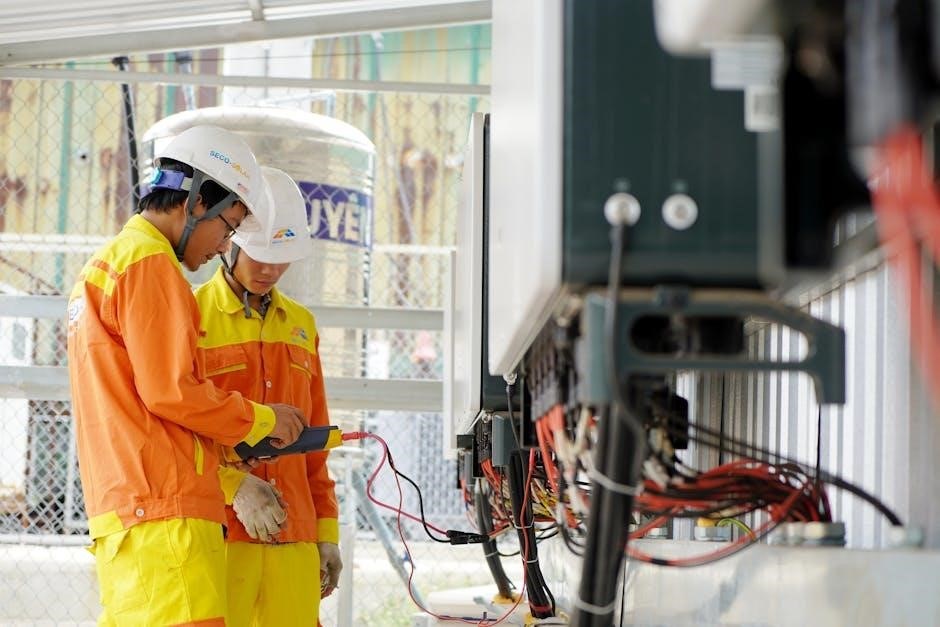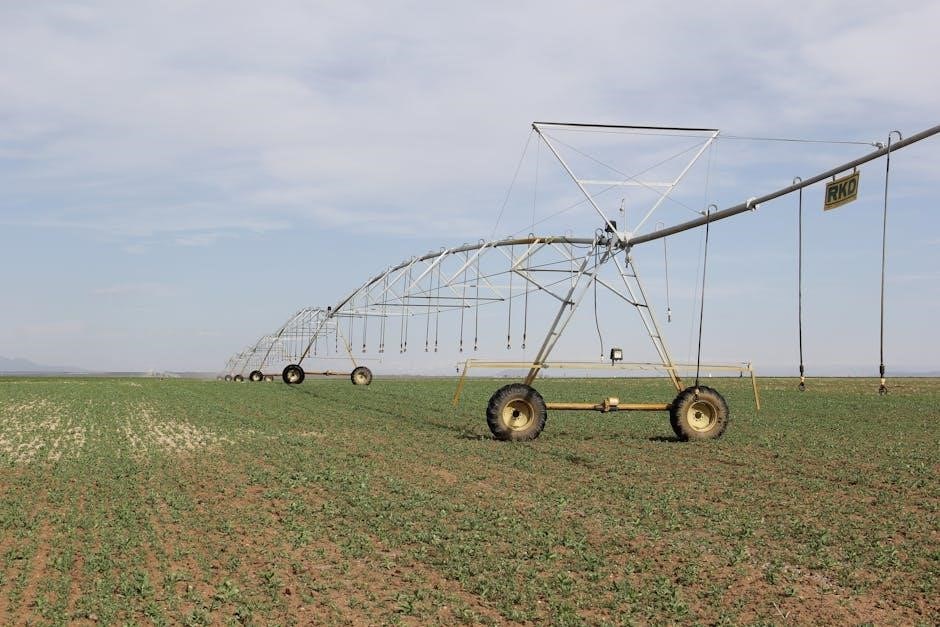
manual irrigation system
Manual irrigation systems are efficient ways to water crops and plants, using
basic
techniques and tools to distribute water effectively, saving time and money for farmers and gardeners everywhere always.
Definition and Importance
A manual irrigation system is a type of irrigation system that relies on manual operation to distribute water to crops and plants. This type of system is commonly used in small-scale farming and gardening, where the water source is limited and the area to be irrigated is relatively small. The importance of manual irrigation systems lies in their ability to provide a cost-effective and efficient way to water crops, especially in areas where access to automated irrigation systems is limited. Manual irrigation systems also allow for more control over the amount of water used, which can help to conserve water and reduce waste. Additionally, manual irrigation systems can be designed to fit specific crop and soil requirements, making them a versatile option for farmers and gardeners. Overall, manual irrigation systems play a vital role in supporting agricultural production and food security, particularly in resource-poor communities. They are a simple yet effective solution for irrigating crops.
Benefits of Manual Irrigation System
Manual irrigation systems offer several benefits, including cost-effectiveness, water conservation, and increased crop yields. By allowing for more control over water distribution, manual irrigation systems can help reduce water waste and minimize the risk of overwatering. This can lead to healthier plants and reduced soil erosion. Additionally, manual irrigation systems are often less expensive to install and maintain than automated systems, making them a more accessible option for small-scale farmers and gardeners. They also provide an opportunity for farmers to monitor and respond to changing weather conditions, soil moisture levels, and crop water requirements. Overall, the benefits of manual irrigation systems make them a valuable tool for agricultural production, particularly in areas where water is scarce or expensive. Manual irrigation systems can be used in a variety of settings, from small gardens to large farms, and can be adapted to meet the specific needs of different crops and soil types. They are a simple and effective way to irrigate crops.

Designing a Manual Irrigation System
Designing involves creating a plan and layout for the system using
technical
data and design steps to ensure efficient water distribution always and everywhere effectively.
Water Pressure and Valve Considerations
When designing a manual irrigation system, it is essential to consider the water pressure and valve requirements. The system’s water pressure will determine the flow rate and overall efficiency of the irrigation system.
Valves play a crucial role in controlling the water flow, and selecting the right type and size of valve is vital to ensure proper system operation.
The valve’s pressure rating and flow capacity must be compatible with the system’s water pressure and flow rate requirements.
Additionally, the valve’s material and construction should be durable and resistant to corrosion to ensure longevity and reliability.
By carefully considering these factors, farmers and gardeners can design a manual irrigation system that is efficient, effective, and easy to maintain, resulting in healthier crops and plants.
Proper water pressure and valve considerations can also help reduce water waste and minimize the risk of system failure, making it a critical aspect of manual irrigation system design.
Design Layouts and Technical Data
Designing a manual irrigation system requires careful consideration of the layout and technical data. The system’s design layout should take into account the size and shape of the area to be irrigated, as well as the type and spacing of the crops or plants.
Technical data such as pipe sizes, flow rates, and pressure drops must also be carefully calculated to ensure the system operates efficiently.
A well-designed manual irrigation system should include a detailed layout of the pipes, valves, and other components, as well as technical specifications for each part.
This information can be used to determine the system’s overall performance and identify potential problems or areas for improvement.
By using design layouts and technical data, farmers and gardeners can create a manual irrigation system that is tailored to their specific needs and helps them achieve their goals.
Accurate technical data and design layouts are essential for a successful manual irrigation system, and can help reduce costs and improve crop yields over time.

Installation Guide for Manual Irrigation System
Manual irrigation system installation requires planning and
execution
of steps to ensure proper setup and functioning always correctly.
Step-by-Step Installation Process
The installation of a manual irrigation system involves several steps, starting with planning and designing the system. This includes determining the water source, pipe layout, and valve placement. Next, the pipes and valves are installed, followed by the connection of the irrigation equipment. The system is then tested to ensure it is working properly. A crucial part of the process is to ensure that the system is installed in a way that minimizes water waste and maximizes efficiency. This can be achieved by using techniques such as drip irrigation, which delivers water directly to the roots of the plants. The installation process also involves considering factors such as soil type, crop type, and climate. By following these steps, a manual irrigation system can be installed that is effective and efficient. The installation process requires careful planning and execution to ensure a successful outcome. Proper installation is essential for the system to function correctly.
Common Mistakes to Avoid During Installation
During the installation of a manual irrigation system, there are several common mistakes to avoid. One of the most significant mistakes is improper pipe sizing, which can lead to reduced water pressure and inefficient watering. Another mistake is inadequate valve placement, which can make it difficult to control the flow of water. Additionally, failing to consider the slope and elevation of the land can result in uneven water distribution. It is also important to avoid installing pipes in areas where they may be damaged by foot traffic or heavy machinery. Furthermore, not testing the system thoroughly after installation can lead to undetected leaks and other issues. By being aware of these potential mistakes, installers can take steps to avoid them and ensure a successful installation. Proper installation techniques and attention to detail are essential for a functional and efficient manual irrigation system. Careful planning and execution can help prevent common mistakes.

Overview of Drip Irrigation
Drip irrigation is a method of watering that uses tubes to deliver water directly to roots, reducing evaporation and runoff, with
various
benefits for farmers and gardeners always.
History and Development of Drip Irrigation
The history of drip irrigation dates back to the 1960s, when farmers in Israel began using plastic tubes to deliver water directly to the roots of plants. This method, known as drip irrigation, was pioneered by companies such as Netafim, which has been a leader in the field since 1965. Over the years, drip irrigation has undergone significant developments, with advances in technology and materials leading to more efficient and effective systems. Today, drip irrigation is used in farms and gardens around the world, and is recognized as a highly efficient method of watering, with benefits including reduced evaporation and runoff, and improved crop yields. The development of drip irrigation has also led to the creation of new products and systems, such as subsurface and point source drip irrigation, which offer even greater efficiency and flexibility. As a result, drip irrigation has become an essential tool for farmers and gardeners seeking to optimize their watering practices.
Advantages of Drip Irrigation Over Traditional Irrigation Methods
Drip irrigation offers several advantages over traditional irrigation methods, including reduced water waste and improved crop yields. By delivering water directly to the roots of plants, drip irrigation minimizes evaporation and runoff, resulting in significant water savings. This method also allows for more precise control over watering, reducing the risk of overwatering and soil erosion. Additionally, drip irrigation can help to reduce soil compaction and improve soil aeration, leading to healthier plant growth. Other benefits of drip irrigation include reduced labor costs, as the system can be automated, and improved fertilizer application, as nutrients can be delivered directly to the roots of plants. Overall, drip irrigation is a highly efficient and effective method of watering, offering numerous advantages over traditional irrigation methods. With its ability to conserve water and improve crop yields, drip irrigation is an attractive option for farmers and gardeners seeking to optimize their irrigation practices and reduce their environmental impact.

and Future of Manual Irrigation System
The manual irrigation system has come a long way in recent years, with advancements in technology and design leading to more efficient and effective watering practices. As the world continues to face water scarcity and environmental challenges, the importance of manual irrigation systems will only continue to grow. In the future, we can expect to see even more innovative solutions and technologies emerge, further improving the efficiency and sustainability of manual irrigation systems; With the help of online resources and guides, farmers and gardeners can easily install and maintain their own manual irrigation systems, reducing their reliance on traditional irrigation methods. As a result, manual irrigation systems will play an increasingly important role in promoting sustainable agriculture and reducing water waste. By adopting manual irrigation systems, individuals can contribute to a more water-efficient future, while also improving crop yields and reducing their environmental impact. This shift towards manual irrigation systems is expected to have a positive impact on the environment and the economy.